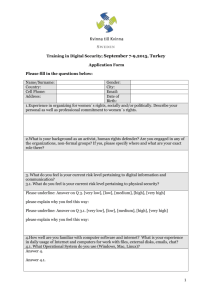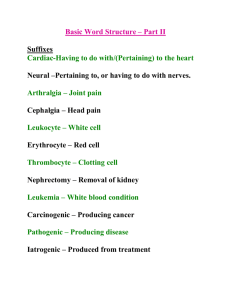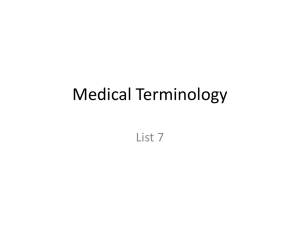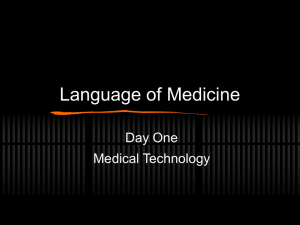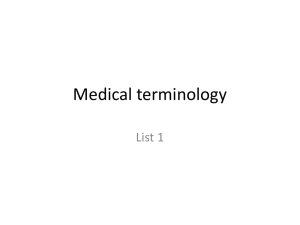File
advertisement
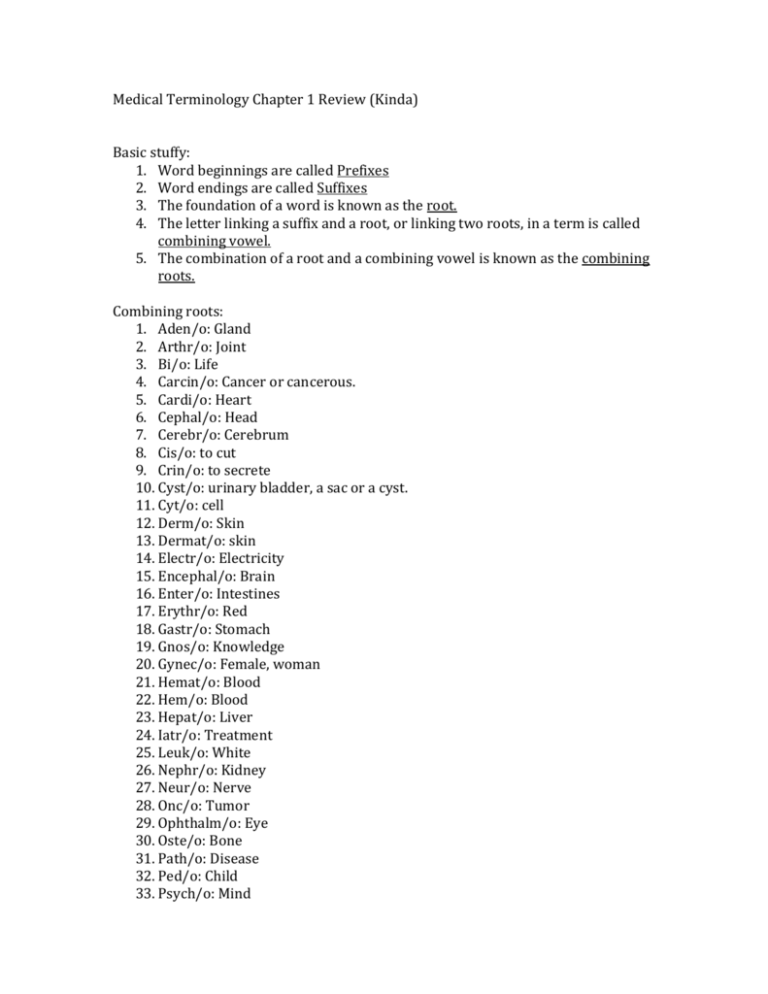
Medical Terminology Chapter 1 Review (Kinda) Basic stuffy: 1. Word beginnings are called Prefixes 2. Word endings are called Suffixes 3. The foundation of a word is known as the root. 4. The letter linking a suffix and a root, or linking two roots, in a term is called combining vowel. 5. The combination of a root and a combining vowel is known as the combining roots. Combining roots: 1. Aden/o: Gland 2. Arthr/o: Joint 3. Bi/o: Life 4. Carcin/o: Cancer or cancerous. 5. Cardi/o: Heart 6. Cephal/o: Head 7. Cerebr/o: Cerebrum 8. Cis/o: to cut 9. Crin/o: to secrete 10. Cyst/o: urinary bladder, a sac or a cyst. 11. Cyt/o: cell 12. Derm/o: Skin 13. Dermat/o: skin 14. Electr/o: Electricity 15. Encephal/o: Brain 16. Enter/o: Intestines 17. Erythr/o: Red 18. Gastr/o: Stomach 19. Gnos/o: Knowledge 20. Gynec/o: Female, woman 21. Hemat/o: Blood 22. Hem/o: Blood 23. Hepat/o: Liver 24. Iatr/o: Treatment 25. Leuk/o: White 26. Nephr/o: Kidney 27. Neur/o: Nerve 28. Onc/o: Tumor 29. Ophthalm/o: Eye 30. Oste/o: Bone 31. Path/o: Disease 32. Ped/o: Child 33. Psych/o: Mind 34. Radi/o: X-rays 35. Ren/o: Kidney 36. Rhin/o: Nose 37. Sarc/o: Flesh 38. Sect/o: To cut 39. Teromb/o: Clot, Cutting 40. Ur/o: Urinary tract, urine Suffixes: 1. –ac: pertaining 2. –al: pertaining to 3. –alga: pain 4. –cyte: cell 5. –ectomy: excision, removal 6. –emia: blood condition 7. –genic: pertaining to producing, produced by, or produced in 8. –gram: record 9. –ic, -ical: pertaining to 10. –ion: process 11. –ist: specialist 12. –it is: inflammation 13. –logy: study of 14. –oma: tumor, mass, swelling 15. –opsy: process of viewing 16. –osis: condition, usually abnormal (slight increase in numbers when used with blood cells) 17. –pathy: disease condition 18. –scope: instrument to visually examine 19. –scopy: process of visually examining 20. –sis: state of 21. –tomy: process of cutting, incision 22. –y: process, condition Prefixes: 1. a-, an-: no, not, without 2. auto-: self 3. dia-: through, complete 4. endo-: within 5. epi-: above, upon 6. ex-: out 7. exo-: out 8. hyper-: excessive, above, more than normal 9. hypo-: deficient, below, less than normal 10. in-: into, in 11. peri-: surrounding, around 12. pro-: before 13. re-: back, backward, again 14. retro-: behind 15. sub-: below, under 16. trans-: across, through The weird words found in the description thingy: 1. Glyc/o: Sugar 2. –um: Structure 3. Orth/o: Straight Exercise D: 1. Cerebral: Pertaining to the cerebrum 2. Biopsy: the process of viewing life. 3. Adenitis: Inflammation of the gland 4. Cephalic: Pertaining to head 5. Carcinoma: cancerous tumor 6. Cystoscopy: The process of viewing the urinary bladder 7. Electrocardiogram: Electricity used to record the heart. 8. Cardiology: The study of the heart 9. Electroencephalogram: electricity used to record the brain 10. Dermatitis: The inflammation of the skin 11. Arthroscopy: The process of viewing your joints 12. Cytology: the study of cells Exercise F: 1. White Blood Cell: Leukocyte. 2. Inflammation of the stomach: Gastritis. 3. Pertaining to being produced by treatment: Iatrogenic 4. Study of kidneys: Nephrology 5. Red Blood cell: Erythrocyte 6. Mass of Blood: Hematoma 7. View of living tissue: Biopsy 8. Pain of nerves: Neuralgia 9. Process of viewing the eye: Ophthalmoscopy 10. Inflammation of the small intestine: Gastritis. Exercise H: 1. Ophthalmoscopy: The process of viewing the eye 2. Ophthalmoscope: The instrument used to view the eye 3. Oncology: the study of tumors 4. Osteitis: Inflammation of the bone 5. Psychosis: Abnormal condition of the mind 6. Thrombocyte: Clotting cell 7. Renal: Pertaining to the kidney 8. Nephrectomy: Kidney removal 9. Osteotomy: The incision of the bone 10. Resection: process of cutting back or removing 11. Carcinogenic: Pertaining to producing cancer 12. Sarcoma: The tumor of flesh Exercise J: 1. Carcinogenic 2. Leukocytosis 3. Hepatoma 4. Arthralgia 5. Endocrine Glands 6. Exocrine Glands 7. Neuralgia 8. Cystitis 9. Hematoma 10. Leukemia 11. Iatrogenic 12. Enteropathy Exercise L: 1. Diagnosis: State of complete knowledge 2. Prognosis: State of knowledge before 3. Subhepatic: Pertaining to below the liver. 4. Pericardium: Structure surrounding the heart 5. Hyperglycemia: Abnormally high sugar levels 6. Hypodermic: Pertaining to below the skin 7. Epigastric: Pertaining to above the stomach 8. Resection: The process of cutting back something 9. Hypoglycemia: Abnormally low sugar levels 10. Anemia: abnormally low blood in skin Exercise M: 1. Study of urinary tract: Urology 2. Study of women and women’s diseases: Gynecology 3. Study of Blood: Hematology 4. Study of tumors: Oncologist 5. Study of kidney: Nephrology 6. Study of Nerves: Neurology 7. Treatment of children: Pediatrics 8. Study of X-rays: Radiology 9. Study of eyes: Ophthalmologist 10. Study of the stomach, and intestines: Gastroenterology 11. Study of Glands that secrete hormones: Endocrinology 12. Treatment of the mind: Psychiatric 13. Study of disease: Pathology 14. Study of heart: Cardiology Exercise N: 1. Cerebrovascular accident: a stroke (Cerebrum) 2. Encephalitis: The inflammation of the brain (Brain) 3. Cystoscope: The instrument to view your urinary bladder (Urinary Bladder) 4. Transhepatic: Pertaining to across or through the liver (Across or Through) 5. Iatrogenic: Pertaining to producing treatment. (Treatment) 6. Hypogastric: Pertaining to below the stomach. (Below or deficient) 7. Endocrine Glands: Glands that secrete within 8. Neurectomy: Removal of the nerves Exercise O: 1. Osteoarthritis 2. Biopsy 3. Urologist 4. Neuropathy 5. Pathogenic 6. Anemia 7. Oncologist 8. Thrombocyte 9. Prognosis 10. Psychologist Exercise P: 1. Radiology 2. Urologist 3. Anemia 4. Cardiologist 5. Arthroscopy Pronounciation thingy, the stressed syllables: (Capital is stressed 1. AdeNItis: Inflammation of a gland 2. AdeNOma: Tumor of a gland 3. AdeNOPathy: Disease condition of glands 4. ANEmia: less blood cells 5. ArTHRALgia: Joint Pain 6. ArTHRItis: Join Inflammation 7. AUtopsy: Process of viewing inside someone 8. BiOLogy: The study of life 9. BIopsy: Viewing of living tissue 10. CarcinoGENic: pertaining to producing cancer 11. CarciNOma: Cancerous tumor 12. CARdiac: Pertaining to the heart 13. CardiOLogy: The study of the heart 14. CePHALic: Pertaining to head 15. CeREbral or CERebral: Pertaining to cerebrum 16. CysTIitis: Inflammation of urinary bladder 17. CysTOScopy: The process of viewing the urinary bladder 18. CyTOLogy: The study of cells 19. DermaTItis: The inflammation of skin 20. DermaTOLogy: The study of skin 21. DiagNOsis: The state of complete knowledge. 22. ElectroCARdiogram: Electricity used to record the heart 23. ElectroenCEPHalogram: Electricity used to record the brain 24. ENdocrine Glands: Glands that secrete into the body 25. EndocriNOLogist: Specialist in stuff that secrete into the body 26. EndocriNOLogy: study of secreting into the body 27. ENdoscope: The instrument used to view the inside 28. EnDOScopy: The process of viewing inside 29. EnteRItis: The inflammation of the intestines 30. EnteROPathy: The disease condition of the intestines 31. EpiDERmis: Pertaining to above the skin 32. EpiGAStric: Pertaining to above the stomach 33. ERYTHrocyte: Red blood cell 34. ExCISion: the process of cutting outside 35. EXocrine glands: The glands that secrete outside 36. GasTRECtomy: Excision of the stomach 37. GAStric: Pertaining to stomach 38. GastroenterOLogy: The study of stomach and intestines. 39. GastROTomy: Cutting the stomach 40. GyneCOLogist: The specialist in female. 41. GyneCOLogy: The study female, and female diseases. 42. HemaTOLogy: The study of blood 43. HemaTOma: The tumor of blood 44. HepaTItis: The inflammation of the Liver 45. HepaTOma: Liver tumor 46. HyperglyCEmia: The extra levels of sugar 47. HypoDERmic: Pertaining to Below skin 48. HypoGAStric: Pertaining to below stomach 49. HypoglyCEmia: Abnormally low levels of sugar 50. IatroGENic: Pertaining to producing treatment 51. InCISion: The process of cutting into 52. LeuKEmia: Abnormal blood condition of white blood cells 53. LEUkocyte: White blood cell 54. LeukocyTOsis: slight increase in the number of white blood cells 55. NePHRECtomy: The excision of the kidney 56. NePHRItis: The inflammation of the kidney 57. NePHROlogy: the study of kidneys 58. NePHROsis: the state of the kidney 59. NePHROTomy: The cutting of kidney 60. NEUral: pertaining to nerves 61. NeuRALgia: Nerve pain 62. NeuroLOGical: Pertaining to the study of nerves 63. NeuROLogy: the study of the nerves 64. OnCOLogist: The specialist of tumors 65. OnCOLogy: the study of tumors 66. OphthalMOLogist: The specialist in eye 67. OphTHALmoscope: The instrument used to view the eye 68. OsteItis: The inflammation of the bone. 69. OsteoarTHRItis: The Inflammation of bone and joint. 70. OsteOTomy: The cutting of the bone 71. PathoGENic: Pertaining to producing disease 72. PaTHOLogist: the specialist in diseases 73. PaTHOLogy: The study of diseases 74. PediATric: Pertaining to treatment for children. 75. PeriCARdium: Structure surrounding the heart 76. ProgNOsis: The state of knowledge before 77. PsyCHIatrist: Specialist in treatment of mind 78. PsyCHIatry: The process of the treatment of mind 79. PsyCHOLogy: the study of the mind 80. RadiOLogy: the study of X-Rays 81. REnal: pertaining to the kidney 82. ReSECtion: cutting back something 83. RetroCARdiac: pertaining to behind heart 84. RhiNItis: The Inflammation of the nose 85. SarCOma: the tumor of the flesh 86. SubhePATic: pertaining to below liver 87. THROMbocyte: The Blood clotting cell 88. TranshePATic: pertaining to Through/Across the liver 89. UROLogy: The study of urinary tract.
